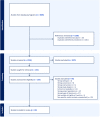The use of technology by seniors with neurocognitive disorders in long-term care: a scoping review
- PMID: 38961323
- PMCID: PMC11220951
- DOI: 10.1186/s12877-024-05174-z
The use of technology by seniors with neurocognitive disorders in long-term care: a scoping review
Abstract
Background: To map the current state of knowledge about the use of technology with seniors with neurocognitive disorders in long-term care to foster interactions, wellness, and stimulation.
Methods: Cumulative Index to Nursing and Allied Health Literature (CINAHL Plus); MEDLINE; PsycINFO; Embase and Web of Science were searched in eligible literature, with no limit of time, to describe the current use of technology by seniors with neurocognitive disorders in long-term care. All types of literature were considered except for theses, editorial, social media. This scoping review was built around the recommendations of Peters et al. (2020 version). Three researchers collaborated on the selection of articles and independently reviewed the papers, based on the eligibility criteria and review questions.
Results: The search yielded 3,605 studies, of which 39 were included. Most technology type reported was robotics. Included studies reports different positive effects on the use of such technology such as increase of engagement and positive.
Conclusion: The study highlights different types and potential benefits of technology for long-term care residents with neurocognitive disorders, emphasizing the crucial need for additional research to refine interventions and their use.
Keywords: Long-term care; Neurocognitive disorder; Older adults; Scoping review; Technology.
© 2024. The Author(s).
Conflict of interest statement
The authors declare no competing interests.
Similar articles
-
Beyond the black stump: rapid reviews of health research issues affecting regional, rural and remote Australia.Med J Aust. 2020 Dec;213 Suppl 11:S3-S32.e1. doi: 10.5694/mja2.50881. Med J Aust. 2020. PMID: 33314144
-
Scoping review protocol: what is the state of evidence for the use of communication apps with immigrant seniors in long-term care and community settings?BMJ Open. 2024 Aug 21;14(8):e089939. doi: 10.1136/bmjopen-2024-089939. BMJ Open. 2024. PMID: 39174072 Free PMC article.
-
Assistive technologies that support social interaction in long-term care homes: a scoping review.JBI Evid Synth. 2021 Oct;19(10):2695-2738. doi: 10.11124/JBIES-20-00264. JBI Evid Synth. 2021. PMID: 34264899
-
Prevention of falls and fall-related injuries in community-dwelling seniors: an evidence-based analysis.Ont Health Technol Assess Ser. 2008;8(2):1-78. Epub 2008 Oct 1. Ont Health Technol Assess Ser. 2008. PMID: 23074507 Free PMC article.
-
Fundamental Care's state of knowledge around the world: Where are we now? A scoping review.J Adv Nurs. 2023 Mar;79(3):865-884. doi: 10.1111/jan.15278. Epub 2022 May 5. J Adv Nurs. 2023. PMID: 35511714
References
-
- World Health Organization. Ageing and health. 2022. Available from: https://www.who.int/news-room/fact-sheets/detail/ageing-and-health. Cited 2024 Jan 29.
-
- American Psychiatric Association . Diagnostic and Statistical Manual of Mental Disorders. Diagnostic and Statistical Manual of Mental Disorders. 2022.
-
- Association québécoise d'établissements de santé et de services sociaux. Pour la qualité de vie des personnes hébergées en CHSLD : mémoire présenté à la Commission de la santé et des services sociaux dans le cadre de la consultation sur les conditions de vie des adultes hébergés en centre d’hébergement et de soins de longue durée. BAnQ numérique. 2014. Available from: https://numerique.banq.qc.ca/patrimoine/details/52327/2456617. Cited 2024 Jan 29.
Publication types
MeSH terms
LinkOut - more resources
Full Text Sources


